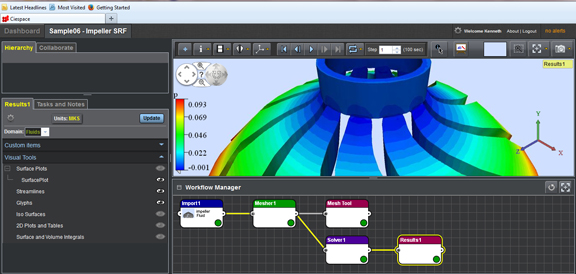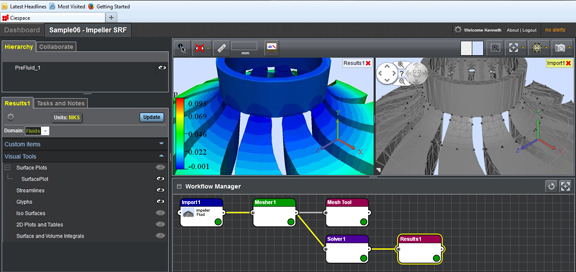Latest News
September 12, 2013
Google Docs brought us word-processing in the cloud. Adobe Creative Cloud is pushing us toward photo-editing in the cloud. Dropbox taught us to manage files and folders in the cloud. It’s inevitable, then, that sooner or later simulation would head to the cloud.
Most computer-aided engineering (CAE) software vendors are bidding their time, observing the trend on the sideline. They support private cloud—dedicated servers installed at clients’ sites to run simulation—but are reluctant to dive into the public cloud. That’s understandable. Their codes and licensing practices are driven, for the most part, by users devoted to desktop workstations and clusters.
Only a handful are publicly championing the on-demand, cloud-hosted approach to simulation. Autodesk, for instance, advocates a hybrid approach, with desktop simulation software augmented by on-demand cloud computing. (For more, read “Autodesk Launches Pay-As-You-Go Simulation,” September 2012.”)
By contrast, San Francisco-based start-up Rescale is offering cloud-hosted infrastructure (or platform as a service, as some might say), targeting simulation users. With its approach, Rescale has attracted quite a number of big-name CAE vendors as partners, including ANSYS, MSC Software, COMSOL, and CD-adapco. That means you can set up your simulation workflow and run your jobs involving products from these vendors on Rescale’s cloud-hosted infrastructure. The latest vendor to jump on-board was Dassault Systemes, which owns the SIMULIA brand.
Perhaps the closest anyone has ever come to adopting the pure SaaS approach to CAE is Santa Clara-based Ciespace, which officially launched its product two months ago. (The company’s preferred pronunciation for its name is “Cee-space,” like See’s Candy. Unfortunately, I butchered it when I called it “Sy-space” like Sci-fi in my video report, posted below. Here’s hoping its marketing folks won’t take me to task.)
With Ciespace CFD, there’s no software to install, no client to run. Your browser is the client. Once you’ve acquired the credentials and logged in, you’re in the dashboard.
Since everything runs in the cloud, you need to first upload the model you want to analyze into your private project space. Once the model is online, you can start creating nodes—geometry cleanup node, editing node, meshing node, solver node, and so on. Each node opens up editable parameters and options to prepare the model. The meshing node, for instance, opens up drop-down menus to choose the type of mesh you desire, and the solver node lets you choose whether you want to run a steady-state or transient simulation.
For collaboration, you may share the entire project with someone, or you may choose to share only a specific node. This security feature lets you restrict, for instance, collaborator X to view and edit only the solver node, and collaborator Y only the meshing node—a clever function to implement a need-to-know collaboration framework for sensitive projects. The node-base system also offers another advantage. Should you choose to rerun the simulation with a different set of values (for instance, with a different mesh type or a different rotation number for a gear), you can edit the node without restarting the entire job.
Perhaps the greatest advantage Ciespace CFD offers is in the meshing and solving stages, where the company’s cloud-hosted servers take over. Offloading the usually compute-intense operations to a remote server leaves your own workstation free from interruption and performance deterioration, a common headache associated with running simulation on local machines.
Once the job is completed, you can display your results as animation, along with customizable options: whether to display flow lines, or to view them as structural effects or flow effects. At every stage, you have the option to download the outcome (like the meshed model or the results) to your local drive for safekeeping or archiving.
Ciespace software uses the drag-and-drop function to load individual nodes into the display window. For comparison, you may load multiple views (for instance, the mesh model and the fluid-flow results) for side-by-side display. The dashboard also functions as a notice board, providing alerts of outstanding jobs and assigned tasks.
Many automotive, aerospace, and defense manufacturing firms will likely shrink from anything cloud-hosted, partly because of the IP sensitivity and partly because they have the budgets to maintain in-house clusters. But researchers, independent design shops, and small to midsized businesses delving into simulation may consider the tradeoff well worth it.
My fellow blogger Beth Stackpole has reported on Altair Engineering’s latest HPC venture. Read about it here.
For more on Ciespace, watch the video report below:
Subscribe to our FREE magazine, FREE email newsletters or both!
Latest News
About the Author
Kenneth Wong is Digital Engineering’s resident blogger and senior editor. Email him at [email protected] or share your thoughts on this article at digitaleng.news/facebook.
Follow DE







